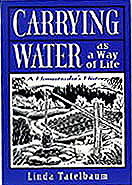| Linda Tatelbaum | |||

|
Praise for Carrying Water
"Spiked with humor, this engaging, true-grit memoir is graced with homespun yet unsentimental observations. Her strenuous quest for the simple life rings true...a passionate plea for ecological sanity." —Publishers Weekly "Sad, noble and beautifully written. It is a book to re-read, one that teaches." —Colby Magazine "It sings from the bottom of a dry well to the ridgepole of a handmade house to an endless town meeting to jars and jars and jars: E.B. White with more heart." —Andy Lacher, owner, Bookstacks Bookstore "This grand narrative of contemporary New England traces one woman's cycle of dropping out and re-engaging in a tiny Maine community. Essential reading." —William Carpenter, poet, Speaking Fire at Stones "The sacrifices made by the '70s counterculturists have rarely been so honestly recorded or the joys so movingly told." —Agnes Bushnell, editor, The Dissident "Read Thoreau and the Nearings, but read Carrying Water first, for the plain, complex facts about homesteading." — Yes! A Journal of Positive Futures |
||
| Excerpts from Carrying Water | |||
| |||
|
Preface It's an economic story.
I never would have said so back in the days of rusted red Volkswagen,
faded pink trailer parked under milkweed in an overgrown field. To
build a house, to plant a garden, to make a life—self-sufficient,
simple. I didn't understand, in 1977, how deeply a homesteader's history
is rooted in the economic forces that surround her. How deeply anyone's
history.
I would have said it was aesthetics, philosophy, botany. I would
have called it poetry, back in the kerosene lamp days, the hauling
water days. I would have claimed to be putting down roots and bringing
forth greens, making a life.
But really, it comes down to making a living: negotiating the complex
dynamic between people, land, money, work. Between me, home, income,
career.
Making do vs. doing without, —which used to mean going off the farm to work, not weight-lifting,
though I suppose it amounts to the same thing. Building muscle, discipline,
character, endurance.
I still say it's not only about money, this story. It's about saving
something besides money. Save time save the planet save face save
water save space save the whales save the children save scraps save
seeds save energy save your breath My life is involved with jars. Up from the cellar I bring them, empty,
to be filled. Down into the cellar I carry them, full. Up from the
cellar I bring them, full, to be emptied. I clean them. I carry them
down again. They feed me. I feed them. Jars are transparent. Their being is nothingness, a vessel, a form
to be filled with other forms, a colorless shape to contain colorful
shapes. One year a jar is red with tomato sauce, the next year yellow
with mustard pickle. Purple grape juice, amber apple sauce, pink rhubarb,
green beans, brown chutney. From year to year the jar transforms.
The same jar emits a different light. Jars preserve a snapshot of the garden's beauty. Dill flowers and
cucumber with floating garlic cloves. Corn and shell beans. Red peppers
and green peppers. In jars we see reflected the delight of our summertime
eyes, once winter comes and turns our brilliant patch of ground to
limitless white. Then there are the jars of grains, the muted browns and tans of rice
and nuts and flour. Big gallon jars hold future breads and cereals,
all their elements separated, waiting to be united by my hands. Dried
foods, these too dwell in jars. Former juice jars and coffee jars
and jelly jars of all sizes and shapes protect shrunken eggplant slices,
curled apple rings, brittle spinach from the vapors of the air. There's
cider, in gallon jugs that once held vinegar or juice. Dandelion wine,
in old wine bottles gathered at parties. Home-brewed beer, in bottles
worth more to me than their 5¢ deposit. And of course, cartons and cartons of just jars, empty jars that
might someday be useful for something. Jars seen at the dump, too
good to pass up. Jars cleaned and saved from purchased mayonnaise,
mustard, wheat germ. Jars that would look nice with flowers in them.
Jars to put nails and screws in. Jars to keep garden seeds in. Jars
to capture fireflies in. Jars for honey. Jars to catch the drip from
a leaking roof. Jars to give as gifts, filled with herb teas or dried
fruit or maple syrup. And doesn't every woman keep a mental list of who has a jar of hers,
whose jar she has? Homestead ecology requires a balance of jars. In
them we gather all that we sow. In them we preserve the fruits of
our labor. They contain our continuing life. Passing them through my hands time and time again, I become one with
jars. I too am a vessel, a temporary dwelling for the stuff of life.
I too am a transparent space existing in the midst of time. My life
too is a series of transformations. What is it that fills me, empties
me, changes my light? I reflect the universe as it flows through me.
I am intimately involved with jars. |
|||
Carrying Water | Writer on the Rocks | Yes & No Front Page | The Author | Excerpts & Reviews | Ordering Information | Contact Us |
|||